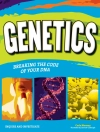‚This book is a must-have for anyone who has faced the challenge of teaching problem solving. The ideas to be learned are supported with a noticeably rich collection of classroom-ready problems, examples of student thinking, and videos. Problem solving is at the center of learning and doing mathematics. And so, Mathematize It! should be at the center of every teacher’s collection of instructional resources.‘
John San Giovanni
Coordinator, Elementary Mathematics
Howard County Public School System, Ellicott City, MD
Help students reveal the math behind the words
‚I don’t get what I’m supposed to do!‘ This is a common refrain from students when asked to solve word problems.
Solving problems is about more than computation. Students must understand the mathematics of a situation to know what computation will lead to an appropriate solution. Many students often pluck numbers from the problem and plug them into an equation using the first operation they can think of (or the last one they practiced). Students also tend to choose an operation by solely relying on key words that they believe will help them arrive at an answer, which without careful consideration of what the problem is actually asking of them.
Mathematize It! Going Beyond Key Words to Make Sense of Word Problems, Grades K-2 shares a reasoning approach that helps students dig into the problem to uncover the underlying mathematics, deeply consider the problem’s context, and employ strong operation sense to solve it. Through the process of mathematizing, the authors provide an explanation of a consistent method—and specific instructional strategies—to take the initial focus off specific numbers and computations and put it on the actions and relationships expressed in the problem.
Sure to enhance teachers’ own operation sense, this user-friendly resource for Grades K-2
· Offers a systematic mathematizing process for students to use when solving word problems
· Gives practice opportunities and dozens of problems to leverage in the classroom
· Provides specific examples of questions and explorations for addition and subtraction of whole numbers as well as early thinking for multiplication and division
· Demonstrates the use of concrete manipulatives to model problems with dozens of short videos
· Includes end-of-chapter activities and reflection questions
How can you help your students understand what is happening mathematically when solving word problems? Mathematize it!
Inhaltsverzeichnis
Publisher′s Acknowledgements
Table of Contents
Video List
About the Authors
Introduction: Why You Need to Teach Students to Mathematize
Problem Solving Strategies Gone Wrong
What is Mathematizing? Why Is It Important
Focus on Operation Sense
Using Mathematical Representations
Teaching Students to Mathematize
Building your Understanding of Operations and Related Problem Situations
Playing in the Mathematizing Sandbox: A Problem-Solving Model
Final Words Before You Dive
Chapter 2: Moving From Counting to Addition & Subtraction
Thinking About Counting, Addition, and Subtraction
Sandbox Notes: Explore Your Thinking
Students and Teachers Think About the Problem
The Development of Courting
Counting or Add-To?
Representing Problem Situations or Representing Answers
Using Children′s Literature to Explore add-To and Take From Situations
Transcribe the Action or Relationship
Moving beyond Twenty
Students and Teachers Think About the Problems
Representing Problem Situations Multiple Ways
Translating the Five Relationships: Try It Out
Teaching Students to Use Concrete and Pictorial Models
Key Ideas
Try It Out!
Identify the Principle
Write the Problem
Change It Up
Reflect
Chapter 3: Add-To Problems: Locating the Change
Thinking About Active Addition Situations
Thinking About Active Addition Situations
Sandbox Notes: Explore Your Thinking
Students and Teachers Think About the Problems
Finding the Unknown, Three Story Structures
Story Structures: Implications for Teaching
Modeling the Active Problem Situation
Model Actions
Distinguish Pictures from Pictorial Representation
Identify Important Features
Creatively Meet Students′ Needs
Using Children′s Literature to Explore Add-To Problems
Make Predictions
Transcribe the Action or Relationship
Digging Deeper into Start Unknown Situations
Complicating Things: The Start Unknown Variation
Strategies for Making Sense of Start Unknown Problem Situation
Separating Computation from Operation
Moving to Equations
Key Ideas
Try It Out!
Identify the Problem Situation
Write the Problem
Change It Up
Reflect
Chapter 4: Take-From Problems: Locating the Change
Thinking About Active Subtraction Situations
Sandbox Notes: Explore Your Thinkin
Students and Teachers Think About the Problems
Finding the Unknown, Three Story Structures
Story Structures: Implications for Teaching
Modeling the Active Problem Situation
Digging Deeper into the Start and Change Unknown Situations
Moving from Concrete to Symbolic Representation
Using Children′s Literature to Explore Take-From Situations
Create Another Outcome
Finding the Unknown Quantity
Key Ideas
Try It Out!
Identify the Problem Situatoon
Write the Problem
Change It Up
Reflect
Chapter 5: Part-Part-While: Understanding the Relationship
Thinking About Part-Part-Whole Situations
Sandbox Notes: Explore Your Thinking
Students and Teachers Think About the Problems
Defining the Part-Part-Whole Situation
Modeling Relationships vs. Action
Moving from Counters to Bar Models
The Special Case of Both Parts Unknown
Modeling Measurement Problems
A Note About the Commutative Property
Using Children′s Literature to Explore part-Part-Whole Situations
Make Predictions
Moving to Larger Whole Numbers
Students and Teachers Think about the Problems
Modeling Measurement Problems
Writing Equations: Addition or Subtraction
Writing Equations: Addition or Subtraction
Finding the Equation in the Model
Key Ideas
Try It Out!
Identify the Problem Sitaution
Write the Problem
Change It Up
Reflect
Chapter 6: Additive Comparison: Another Kind of Relationship
Thinking About Additive Comparison Situation
Students and Teachers Think about the Problems
Early Years Comparisons
Additive Comparison Situations
Building Models for Comparisons
Students and Teachers Think About the Problems
Making Use of Models For Thinking
The Language of Comparisons
Language Can Get Tricky
Building Bar Models for Comparisons
Problem Posing as an Instructional Strategy
Using Children′s Literature to Explore Additive Comparison Situations
Create Another Outcome
Key Ideas
Try It Out
Identify the Problem Situation
Write a Problem
Change It Up
Reflect
Chapter 7: Early Multiplication and Division: Patterns and Predictions
Thinking about Early Multiplicative Thinking
Sandbox Notes: Explore Your Thinking
Students and Teachers Think About the Problem
Modeling Even and Odd Numbers
Equal Groups Problem Situation
Using Patterns to Identify Even and Odd Numbers
Using Children′s Literature to Explore Early Multiplication
Transcribe the Action or Relationship
Bringing Another Dimension with Arrays
Recognizing Area/Array as a Problem Situation
Building an Understanding of Arrays as Structures
Using Children′s Literature to Explore Arrays
Transcribe the Action or Relationship
Setting the Stage Division
Equipartitioning
Two Models for Division
Using Children′s Literature to Explore Early Division
Transcribe the Action or Relationship
Key ideas
Try It Out
Identify the Problem Situation
Write the Problem
Change It Up
Reflect
Chapter 8: Changing How You Teach Word Problems
Getting into the Mathematizing Sandbox
8 Shifts in Instruction for Building Students′ Problem-Solving Skills
Do Word Problems for Sense-Making
Treat Context and Computation Separately
Create More and Varied Representations
Explore All the Work Operations can Do
Add Operation Sense Routines with a Variety of Problem Situatons
Listen to Students and Be Curious
Make Time for Mathematizing in the Sandbox
Guidance for Moving Forward: FAQ′s
Finding Unexpected Mathematics in Stories
Über den Autor
Winner of the Presidential Award for Excellence in Science and Mathematics Teaching, Linda M. Gojak directed the Center for Mathematics and Science Education, Teaching, and Technology (CMSETT) at John Carroll University for 16 years. She has spent 28 years teaching elementary and middle school mathematics, and has served as the president of the National Council of Teachers of Mathematics (NCTM), the National Council of Supervisors of Mathematics (NCSM), and the Ohio Council of Teachers of Mathematics.
![Kimberly Morrow-Leong & Sara Delano Moore: Mathematize It! [Grades K-2] (ePUB) Cover von Kimberly Morrow-Leong & Sara Delano Moore: Mathematize It! [Grades K-2] (ePUB)](https://static.worldofdigitals.com/info_webp/375/9781071811375.webp)











